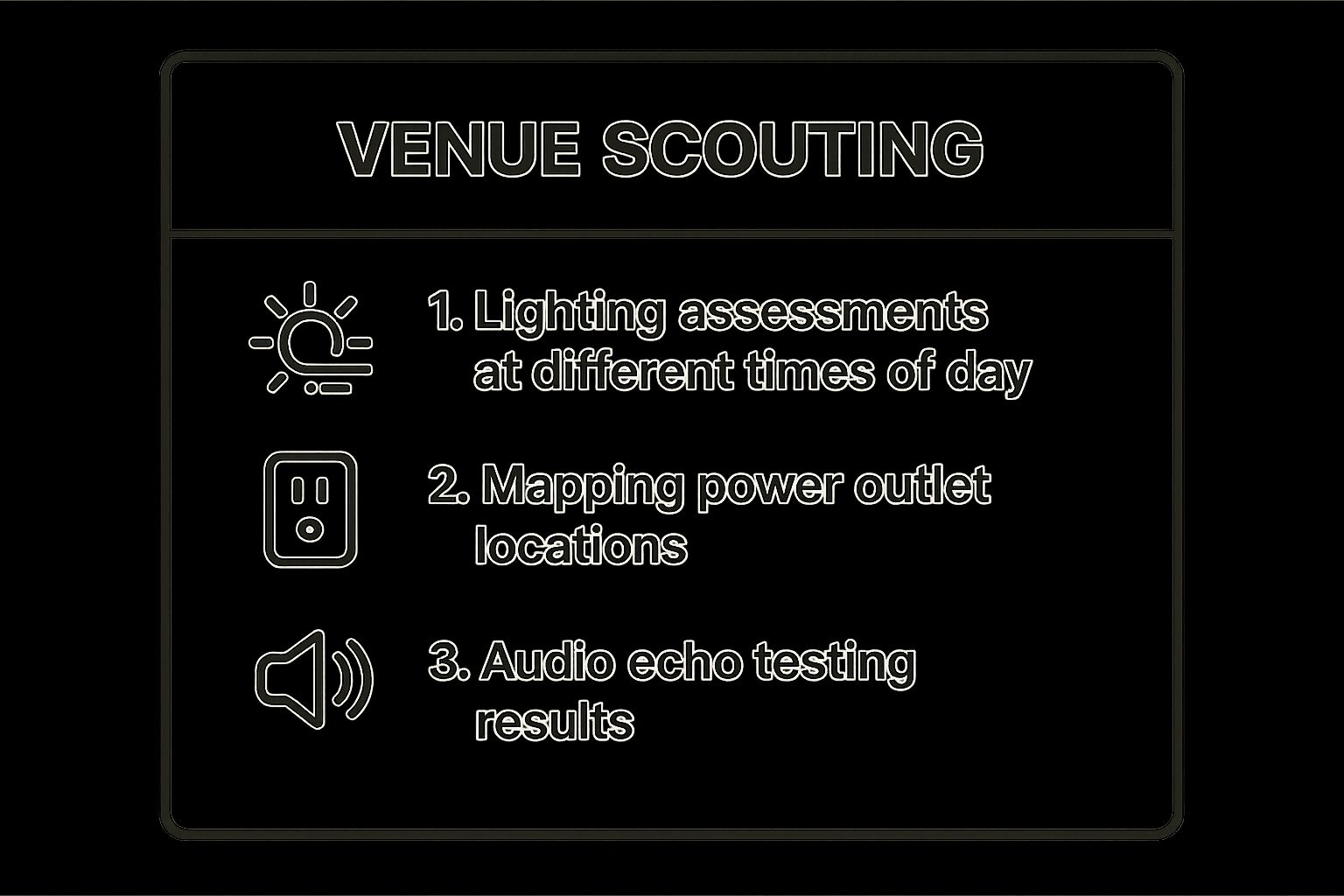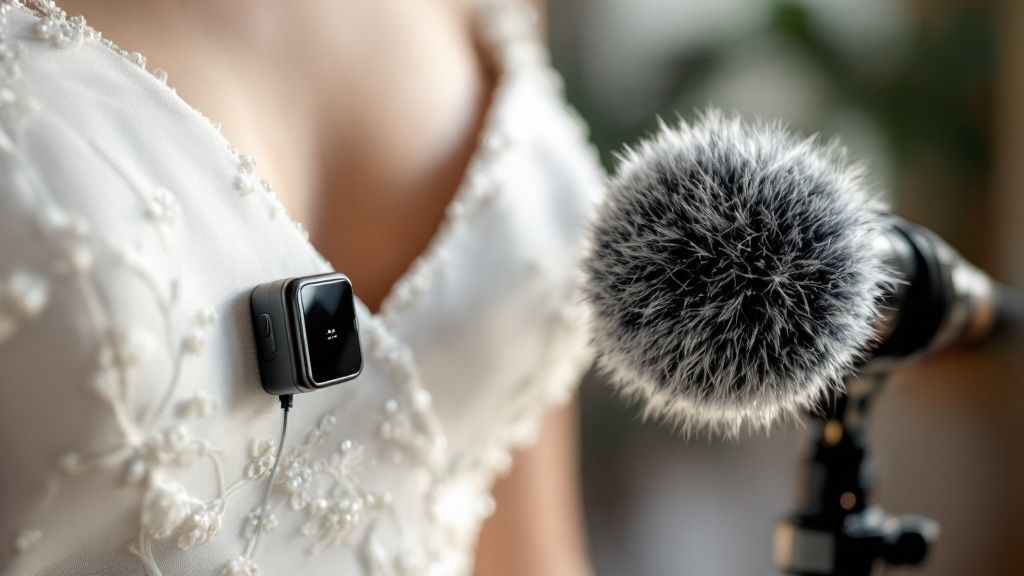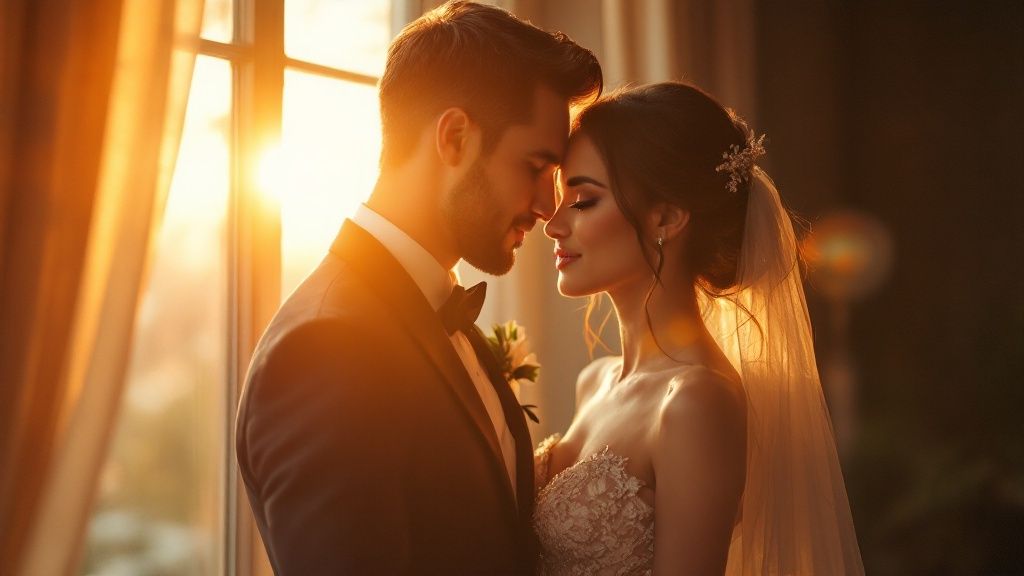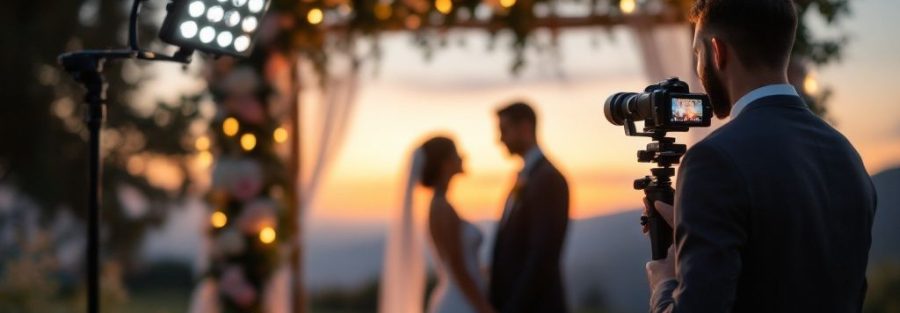Creating a truly memorable wedding film goes way beyond just hitting the record button. It's about telling a story, capturing raw emotion, and producing a cinematic keepsake the couple will cherish forever. But with so much happening on the big day, from tearful vows to energetic dance floors, how do you ensure you nail every crucial shot without missing a beat? This guide breaks down seven game-changing wedding videography tips that separate the amateurs from the pros. We are not just talking about theory; these are the practical, on-the-ground strategies that make a tangible difference in your final product.
We'll dive into actionable advice for everything from pre-planning and audio capture to camera movement and essential contingency plans. While these tips are tailored for weddings, understanding the core principles behind them is key. To truly elevate your craft, exploring broader professional video production best practices can provide a solid foundation for any project. Whether you're just starting out or looking to refine your craft, these insights will give you a clear blueprint to produce stunning, professional-quality wedding videos every single time. Let's get started.
1. Scout the Venue in Advance
Showing up on the wedding day without ever having seen the venue is like trying to cook a gourmet meal in an unfamiliar kitchen. You might pull it off, but the stress and uncertainty are avoidable. This is where pre-wedding venue scouting comes in. It’s a game-changing practice where you visit the location days or even weeks before the event to get the lay of the land.
This reconnaissance mission allows you to understand the lighting, acoustics, layout, and potential shooting angles long before the pressure is on. It's your chance to plan camera placements, identify the best vantage points for the ceremony and reception, and anticipate any technical challenges. Think of it as creating a strategic blueprint for the wedding day, a crucial first step in our list of wedding videography tips.
The Payoff of Preparation
Legendary wedding filmmaker Ray Roman often emphasizes how preparation is the foundation of cinematic storytelling. Proper scouting prevents surprises that can derail your creative flow. For instance, videographer Matt Johnson discovered a reception hall had terrible acoustics during a scout, prompting him to bring extra wireless mics to capture clean audio for the speeches. Similarly, Sarah Chen found a hidden, elevated spot perfect for a drone launch during her visit, a perspective she would have completely missed on the day of the event.
Pro Tip: When scouting, don’t just look; listen. Clap your hands in the ceremony space and reception hall to check for echoes. Hum or speak at a normal volume to see how sound travels. This quick test can tell you a lot about your audio strategy.
Your Venue Scouting Checklist
To make your visit as productive as possible, treat it like a scheduled shoot.
- Time It Right: Visit the venue around the same time of day as the planned ceremony to see exactly how the natural light will fall.
- Map Your Power: Take photos and make detailed notes of every power outlet's location. This will save you from frantically searching for one on the wedding day.
- Chat with the Coordinator: The on-site coordinator knows the venue best. Ask them about any restrictions, such as rules about drone usage or where you can place tripods. This is also a great time to learn more about how to choose the perfect wedding venue from a professional's perspective.
- Create a Draft Shot List: Use your observations to build a preliminary shot list, noting specific angles and compositions you want to capture.
This next infographic summarizes the essential data points you should gather during your venue visit.

Focusing on these three core areas of lighting, power, and audio during your scout provides a solid technical foundation for a successful wedding film.
2. Capture High-Quality Audio
A stunning wedding film can be ruined by crackly, muffled, or inaudible sound. High-quality audio is the soul of a wedding video; it captures the emotion in the vows, the laughter in the speeches, and the energy of the celebration. This means going beyond your camera’s built-in microphone and using a dedicated, multi-layered audio strategy to ensure every word is crystal-clear.
This involves using a combination of wireless lavalier microphones for key speakers, on-camera shotgun mics for ambient sound, and external recorders tapped into the venue’s sound system. This approach creates a rich, immersive soundscape and provides crucial backups. It's one of the most critical wedding videography tips because great visuals with bad audio will always feel unprofessional.

The Payoff of Preparation
Legendary filmmakers like those at Stillmotion are known for their pristine audio, which makes their films incredibly emotive and engaging. Wedding filmmaker Jordan Hammond, for instance, once captured perfectly clear vows during a windy outdoor ceremony using a four-mic setup, a feat impossible with a single on-camera mic. Similarly, Peter McKinnon's wedding films are praised for their flawless audio, often achieved by using dual wireless systems on the groom to guarantee a clean signal.
Pro Tip: Always record about 30 seconds of "room tone" in each location. This is the silent, ambient sound of the space. Having this recording makes it much easier to smooth out audio edits and remove unwanted noises in post-production.
Your Audio Capture Checklist
To ensure your sound is as cinematic as your visuals, you need a solid game plan.
- Mic Up the Key Players: Place wireless lavalier mics on both partners and the officiant. This is non-negotiable for capturing intimate vows.
- Create Redundancy: Always have a backup. If you put a lav mic on the groom, also place a small recorder in his jacket pocket. Record audio on multiple cameras.
- Coordinate with the DJ: For the reception, ask the DJ for a direct feed from their soundboard. This is the best way to capture clean audio for speeches and music. Learn more about professional DJ sound solutions to better understand how to collaborate with them.
- Monitor Your Levels: Wear headphones during the key moments like the ceremony and speeches. Watching the audio meters isn't enough; you need to hear what's being recorded to catch issues like wind noise or signal interference.
By prioritizing your audio strategy, you ensure that the heartfelt words and joyful sounds of the day are preserved with the same care as the beautiful imagery.
3. Use Multiple Camera Angles
Relying on a single camera for a wedding is like trying to tell a story with only one character's point of view. You'll capture the main events, but you'll miss the rich tapestry of emotions and reactions happening simultaneously. Using multiple camera angles involves placing several cameras strategically to capture the same moment from different perspectives, ensuring you don't miss a single tear, laugh, or loving glance.
This multi-camera approach is the secret sauce behind dynamic, professional-looking wedding films. It gives you the raw footage needed in post-production to create a compelling narrative, cutting between a wide shot of the vows and a close-up of a parent's emotional reaction. This technique transforms a simple recording into a cinematic experience, a key practice in our guide to wedding videography tips.
The Payoff of Preparation
Renowned wedding cinematographer Ray Roman is a master of the multi-angle approach, often using it to capture unexpected moments like a surprise proposal during a reception that a single camera would have undoubtedly missed. Similarly, companies like Film Supply Co. frequently use four or five camera angles just for the ceremony. This comprehensive coverage allows them to craft wedding films that feel immersive and emotionally resonant, capturing both the grand scale and the intimate details.
Pro Tip: Before the ceremony starts, sync all your cameras by recording a sharp, loud sound, like a clapboard or even a loud hand clap. This creates a clear spike in the audio waveform for each camera, making it incredibly easy to align the clips perfectly in your editing software.
Your Multi-Angle Checklist
To execute a multi-camera shoot smoothly, a little planning goes a long way.
- Assign Each Camera a Job: Designate specific roles. Have one camera on a tripod for a wide, static shot of the entire ceremony space. Use another for tight shots of the couple's faces, and perhaps a third roving camera to capture guest reactions.
- Match Your Settings: Ensure all cameras are set to the same frame rate, resolution, and color profile. Mismatched settings create a jarring visual shift when you cut between angles and a major headache in post-production.
- Plan Your Positions: Place your cameras to create a "triangle" of coverage around the main action. This avoids shooting the back of another camera and provides varied, interesting perspectives. For more on this, check out our guide on the best cameras for wedding videography and how to pair them.
- Pack Extra Media: More cameras mean more footage. Double-check that you have more than enough memory cards and batteries for every camera body to last the entire day.
4. Master Natural Lighting Techniques
Relying solely on bulky, artificial lights can disrupt the intimate atmosphere of a wedding. Mastering natural lighting is about harnessing the power of the sun, windows, and ambient sources to create soft, romantic, and cinematic visuals. This skill is arguably one of the most important wedding videography tips because it allows you to work discreetly and efficiently, capturing authentic moments without intrusive setups.
Learning to see and shape available light separates good footage from breathtaking cinematography. It means understanding how to position the couple near a large window for flattering key light during prep or scheduling portraits during the coveted "golden hour." It’s about adapting to changing conditions and using the environment to your creative advantage, ensuring the final film feels as warm and genuine as the day itself.

The Payoff of a Light-First Approach
Filmmakers like Peter McKinnon and Matti Haapoja have built careers on their ability to create stunning visuals primarily with natural light. Their work demonstrates that you don't need a truck full of gear to achieve a high-end look. For instance, in his wedding work, Jordan Hammond masterfully uses the soft, flickering glow of candlelight during receptions to create a deeply romantic and intimate mood, a feat impossible to replicate with harsh LED panels. This approach not only preserves the event's ambiance but also produces a more organic and timeless film.
Pro Tip: Your camera's histogram is your best friend. Instead of relying on the monitor, use the histogram to accurately judge your exposure, especially when shooting bright scenes or dark, moody receptions. This ensures you capture the maximum dynamic range and avoid clipped highlights or crushed blacks.
Your Natural Lighting Checklist
To make the most of the light available on the wedding day, keep these practical tips in mind.
- Hunt for Golden Hour: Collaborate with the couple and photographer to schedule at least 20 minutes of portrait time during the hour before sunset. The soft, directional, and warm light is universally flattering.
- Use Windows as Softboxes: During indoor prep, position your subjects facing a large window. This creates a beautiful, soft light that wraps around their features, minimizing harsh shadows.
- Bounce, Don't Blast: Carry a simple 5-in-1 reflector. Use the white or silver side to gently bounce window light back onto your subjects, filling in shadows on their faces without needing an artificial source.
- Know Your Gear's Limits: Before the wedding, test your camera's low-light performance. Understand at which ISO setting the image starts to get unacceptably noisy, so you know when you absolutely must introduce a small light. Discover more creative ways to enhance the mood with our guide to wedding lighting ideas.
- Expose for Skin Tones: In mixed or tricky lighting, prioritize a correct exposure for the subjects' skin tones. Backgrounds can be slightly over or underexposed, but the people must look natural.
5. Stay Unobtrusive and Blend In
The best wedding videographers are often the ones you barely notice. Being unobtrusive is the art of capturing the most authentic, raw emotions of the day without interfering with them. It means becoming a quiet observer, documenting moments as they happen organically rather than directing them. This documentary-style approach allows you to capture genuine tears, unrestrained laughter, and subtle glances that staged shots simply cannot replicate.
This technique is about more than just staying out of the way; it's a mindset focused on preserving the integrity of the event. By blending into the background, you allow the couple and their guests to forget they are being filmed, leading to a more natural and emotionally rich final product. Think of yourself as a storyteller capturing the day as it unfolds, not as a director orchestrating a scene. This is one of the most crucial wedding videography tips for creating a timeless film.
The Power of Invisibility
Pioneering cinematography groups like Stillmotion built their reputation on this very principle. Their films feel incredibly intimate because they master the art of being present without being intrusive. Wedding videographer Sam Hurd often uses long telephoto lenses to capture candid, close-up emotional moments from a distance, ensuring his presence doesn't alter the interaction. These filmmakers prove that the most powerful shots come from observation, not intervention.
By adopting this approach, you transform from a vendor into a silent witness to the couple's story. The result is a film that feels less like a production and more like a collection of cherished memories, just as the couple experienced them.
Pro Tip: Your attire is your camouflage. Ask the couple about the wedding's dress code beforehand. Dressing similarly to the guests (e.g., a dark suit for a formal event) helps you blend in seamlessly and reduces the visual distraction of your presence.
Your Unobtrusive Videography Checklist
To master the art of blending in, focus on your gear, movement, and awareness.
- Use the Right Lenses: A 70-200mm lens is your best friend for ceremonies and speeches. It allows you to get tight, emotional shots without getting in anyone's personal space.
- Silence Your Gear: Activate your camera's silent shutter or electronic shutter mode, especially during quiet, intimate moments like the vows. Turn off all beeps and audio alerts.
- Know the Timeline: Study the day's schedule to anticipate key moments. Knowing where to be and when means you can get into position early and avoid scrambling around when something important is happening.
- Coordinate with the Photographer: Sync up with the photographer to avoid stepping into each other's shots. Decide on designated "zones" for the ceremony so you both have clean lines of sight without creating a distraction.
6. Plan and Execute Smooth Camera Movements
Static, shaky footage can make a wedding film feel amateurish and jarring. Professional videography, on the other hand, uses deliberate and fluid camera movements to create a cinematic, high-production feel. This involves using tools like gimbals, sliders, and stabilizers to introduce motion that enhances the story without distracting from it.
These movements are about more than just looking cool; they're about guiding the viewer's eye and adding emotional weight. A slow slide can reveal the bride in her dress for the first time, while a graceful gimbal orbit around the couple during their first dance can amplify the feeling of romance. This technique is one of the most impactful wedding videography tips for transforming good footage into a breathtaking film.
The Power of Purposeful Motion
Filmmaker Peter McKinnon is famous for his signature gimbal movements that add a dynamic, flowing quality to his work, especially during couple portraits. His style demonstrates that movement should always have a purpose. For example, during venue scouting, videographer Ben Hartley noticed a long, beautiful aisle and planned a slow, forward-pushing slider shot to build anticipation as the bride walked toward the altar. This planned motion created a much more dramatic reveal than a simple static shot ever could.
Pro Tip: Don't overuse complex movements. Sometimes the most powerful shot is a very slow, subtle push-in or pull-out on a tripod. This simple motion can draw the viewer into an emotional moment, like the exchange of vows, without feeling overly technical.
Your Smooth Movement Checklist
To make your camera movements look effortless, you need a solid plan.
- Practice Extensively: Become an expert with your gimbal or slider before the wedding day. Practice walking patterns (like the "ninja walk") to minimize bouncing.
- Keep it Slow and Steady: Fast, jerky movements are disorienting. Aim for slow, deliberate, and controlled motion that feels natural and cinematic.
- Map Your Movements: During your venue scout, identify key moments where a specific movement would be powerful. Note these in your shot list (e.g., "Slider shot from left to right during cake cutting").
- Pack Backup Power: Gimbals and motorized sliders are battery hogs. Always carry multiple fully charged backup batteries to avoid equipment failure at a critical moment.
Mastering smooth camera movements is a skill that separates the pros from the amateurs, adding immense production value to your final film.
This video tutorial provides an excellent overview of essential camera movements that can elevate the quality of your wedding videography.
7. Have Backup Equipment and Contingency Plans
In wedding videography, there are no do-overs. A technical glitch during the vows or a dead battery during the first dance can be catastrophic. This is why having a robust backup system isn’t just a good idea; it’s a non-negotiable professional standard. A contingency plan involves bringing duplicates of all critical gear and having a strategy for when things inevitably go wrong.
This isn’t about being pessimistic; it’s about being a professional who guarantees results. From extra cameras and lenses to a surplus of batteries and memory cards, your backup kit is your insurance policy. It ensures that no matter what technical gremlin appears, the couple’s once-in-a-lifetime moments are captured flawlessly. This level of preparedness is one of the core wedding videography tips that separates seasoned pros from amateurs.
The Payoff of Preparation
Legendary wedding videographer Ray Roman famously tells a story of his main camera malfunctioning right as the bride began her vows. Because he had an identical backup camera on a second tripod already rolling, he seamlessly switched to its footage, and the client never even knew there was an issue. Similarly, during a windy beach wedding, Peter McKinnon's primary gimbal failed after getting sand in its motors, but his quick switch to a handheld rig saved the cinematic shots he needed.
Pro Tip: Your backup plan should extend to data. Use a camera with dual card slots to record simultaneously to two cards. After the wedding, immediately back up all footage to at least two separate hard drives before you even think about heading home.
Your Backup and Contingency Checklist
To ensure you're fully prepared, build a system that covers every potential point of failure.
- Duplicate Your Core Gear: Always bring at least two camera bodies, your most-used lenses, and extra tripods or monopods.
- Power Up: Pack at least double the number of batteries you think you'll need for cameras, audio recorders, and lights. Portable power banks are also essential.
- Overprepare on Storage: Bring more memory cards than you could possibly fill. A card failure is one of the most common and devastating issues.
- Create a "Go Bag": Keep a smaller, accessible bag with your most critical backups (one camera body, lens, battery, and mic) ready for a lightning-fast swap. This way, you're not digging through your main case during a critical moment.
- Know Your Costs: Understanding the investment required for professional-grade primary and backup gear can provide insight into what goes into wedding videographer pricing and the value of hiring a prepared professional.
By building redundancy into every part of your workflow, you can confidently handle any unexpected challenge the wedding day throws at you.
7 Key Wedding Videography Tips Comparison
| Technique | Implementation Complexity 🔄 | Resource Requirements ⚡ | Expected Outcomes 📊 | Ideal Use Cases 💡 | Key Advantages ⭐ |
|---|---|---|---|---|---|
| Scout the Venue in Advance | Medium (Requires site visits) | Moderate (Time and travel costs) | Reduced surprises, efficient setup | Outdoor/complex venues, unfamiliar locations | Better planning, backup locations |
| Capture High-Quality Audio | High (Complex setup/monitoring) | High (Multiple mics, wireless gear) | Crystal-clear audio, professional quality | Vow & speech capture, noisy or large venues | Redundancy, flexible post-production |
| Use Multiple Camera Angles | High (Multi-device coordination) | High (Several cameras/storage) | Comprehensive coverage, dynamic edits | Large weddings, key moments needing full coverage | Multiple perspectives, backup coverage |
| Master Natural Lighting Techniques | Medium-High (Technical skills) | Low-Moderate (Special lenses, reflectors) | Cinematic, authentic atmosphere | Outdoor & indoor ceremonies with natural light focus | Authentic look, less intrusive setup |
| Stay Unobtrusive and Blend In | Medium (Skill & timing) | Low (Compact, quiet gear) | Genuine, emotional moments recorded | Intimate ceremonies, documentary-style weddings | Emotional authenticity, minimal disruption |
| Plan and Execute Smooth Movements | High (Skill & equipment) | High (Gimbals, sliders, batteries) | Cinematic, polished motion shots | Portraits, dramatic reveals, cinematic storytelling | Professional quality, emotional impact |
| Backup Equipment & Contingency | Medium-High (Management & prep) | Very High (Duplicate gear & power) | No lost moments, uninterrupted coverage | All weddings, especially high-stakes/unrepeatable | Reliability, peace of mind |
Bringing It All Together: Your Next Steps to Unforgettable Films
We've journeyed through the seven pillars of exceptional wedding videography, from the foundational work of scouting a venue to the dynamic art of camera movement. Each of these wedding videography tips is a crucial piece of a much larger puzzle. Think of them not as a checklist to be completed, but as a mindset to adopt. Mastering them transforms you from someone who simply records an event into a storyteller who preserves a legacy.
The core takeaway is that proactive preparation is everything. A stunning wedding film isn't a product of luck; it’s the result of meticulous planning, technical skill, and the ability to anticipate moments before they happen. Having backup gear isn't just a good idea, it's a professional necessity. Capturing clean audio isn't a bonus, it's half the viewing experience. Staying unobtrusive isn't just about being polite, it's how you capture the most authentic, unguarded emotions that make a film truly powerful.
Turning Theory into Practice
So, what's next? The journey from understanding these concepts to executing them flawlessly is paved with practice. Don't wait for the next wedding to try out a new gimbal move or test your lavalier mic setup.
- Create practice projects: Film a friend’s picnic, a local event, or even just a walk in the park. Focus on implementing one or two of these tips at a time.
- Analyze your work: After a shoot, critically review your footage. Where was the lighting perfect? When did the audio suffer? Could a different angle have told a better story?
- Study the craft: The work doesn't stop when the cameras are packed away. The magic truly comes alive in the edit. Beyond choosing software, understanding essential video editing techniques is vital to transform your raw footage into a captivating wedding film. This is where you'll weave together the narrative, color grade for emotion, and sync that crystal-clear audio to the perfect visual moments.
Ultimately, these wedding videography tips are about building a reliable system that allows your creativity to flourish. When your technical execution becomes second nature, you free up your mental energy to focus on what truly matters: capturing the fleeting glances, the joyful tears, and the unspoken connections that define a wedding day. You become a historian of happiness, an architect of memories. Embrace this process, stay curious, and you'll be well on your way to creating films that aren't just watched, but cherished for a lifetime.
Ready to see these principles in action? The team at 1021 Events lives and breathes these professional standards, using state-of-the-art equipment and creative expertise to capture your big day flawlessly. Learn more about how we can create a cinematic masterpiece for you by visiting us at 1021 Events.




